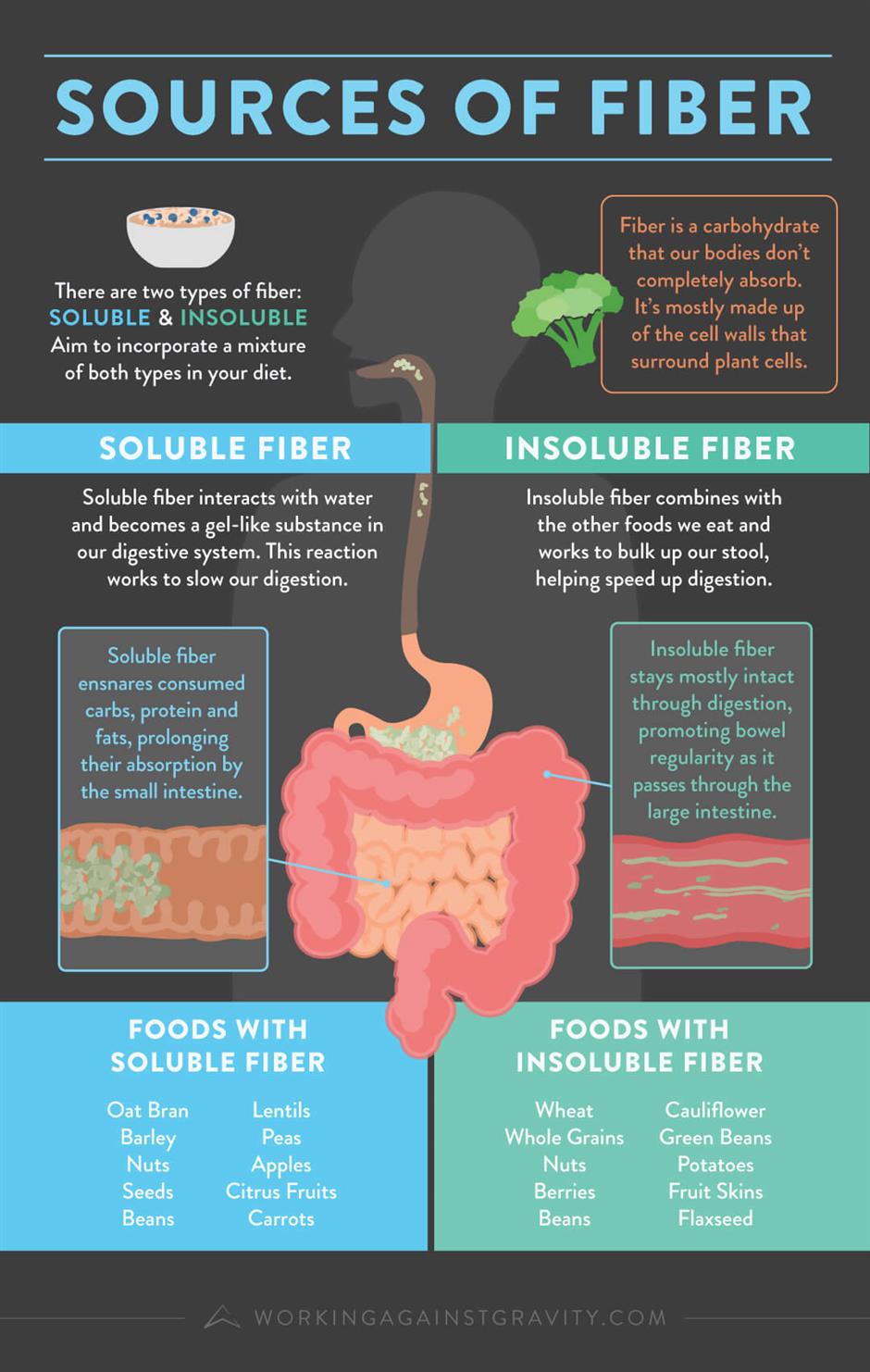
Fiber is integral to a healthy diet and provides many essential benefits. That is why every nutrition coach at Working Against Gravity prescribes a fiber goal along with a personalized macro prescription.
Today, we'll discuss why fiber is important, the different types of fiber, how much fiber you need, and where to find it. We'll also discuss fiber supplements and when you may want to try one.
What is Fiber?
Fiber is primarily found in the cell walls of plants. More specifically, fiber is found in the tougher parts of plants, such as the stalks or skins. Fiber passes through your digestive system relatively intact, contributing to gut health, satiety, and other processes along the way.
Since plants (aka fruits and veggies) are primarily made up of carbohydrates, fiber is listed on nutrition labels underneath carbohydrates to indicate what percentage of the total grams of carbohydrates is made up of fiber [1].
Advertisement
Types of Fiber
In addition to aiming for a total amount of fiber daily, a mixture of both fiber types can help you feel your best.
Soluble Fiber
Soluble fiber interacts with water and becomes a gel-like substance in your GI tract, slowing digestion. Since you obtain most of the nutrients in your food through passive absorption, fiber gives your body a chance to soak up all the vitamins and minerals in your food. You can find soluble fiber in oat bran, barley, nuts, seeds, beans, lentils, peas, apples, citrus fruits, and carrots [1,2].
Insoluble Fiber
Insoluble fiber combines with the other foods you eat and works to bulk up our stool, helping speed up digestion. Insoluble fiber is found in wheat, whole grains, nuts, beans, cauliflower, green beans, and potatoes [1,2]
In addition to aiming for a total amount of daily fiber, it’s essential to consider if you’re getting a mixture of both fiber types to help you feel your best. We’ll talk more about how much fiber you need later on in this blog.
Advertisement

What Does Fiber Do?
Without enough fiber in your diet, you may experience constipation. Fiber also helps you feel fuller, increases food satisfaction, and supports weight loss while increasing your absorption of essential nutrients from your food [1].
Regular fiber consumption also has a positive effect on heart health. Fiber can help lower cholesterol, supporting cardiovascular health [2]. Studies have proven that increased fiber intake reduces cardiovascular and coronary disease risk [3]. It can also treat diverticulosis, diabetes, and heart disease. It is even associated with a lowered risk of some forms of cancer [1].
Should I Take Fiber Supplements?
The best way to get fiber is through a diet rich in whole and unprocessed foods. The fiber in food is more bioavailable than fiber found in supplements, and eating high-fiber foods helps you feel full. So, we recommend obtaining as much fiber as possible from whole-food sources.[4]
Advertisement
If you need to supplement your fiber intake, look for something with a good mixture of both kinds of fiber and check the ingredients list. Better-quality supplements will have far fewer side effects. Always speak with a doctor before making your final decision.
How Much Fiber Do I Need?
Due to the high rate of heart disease in the United States, low fiber intake is now considered a national health issue. The National Institutes of Health recommends that adult women eat at least 25 grams of fiber daily and adult males eat 38 grams. In comparison, adult women 51 years or older should consume 21 grams, and adult men 51 years or older should consume 30 grams daily [5].
If you’re new to adding fiber to your diet, we suggest taking it slow. If you add too much too soon, you may have some not-so-pleasant side effects, such as bloating, cramping, or diarrhea. Incorporating fiber into your diet over time helps lessen these effects and allows your body to adjust until they cease altogether. Staying hydrated will help mitigate adverse side effects [2].
Advertisement
How Can I Add More Fiber to My Diet?
Here are a few simple changes you can make to add more high-fiber foods to your diet:
- Switch to whole grains. Grab whole-grain options for bread, rice, and pasta whenever possible.
- Diversify. Add whole grains or veggies to your casseroles, soups, and stews. Include cabbage in your salads and throw some seeds in your smoothie.
- Try the beans. Legumes like beans or lentils provide a lot of fiber. Add them to soups and salads to quickly increase fiber.
- Start your day with fiber. Choose a breakfast that provides at least 5 grams of fiber to start your day and keep you fueled for your morning activities.
- Snack smart. Choose fruits and veggies for your snacks! Opting for celery and hummus or apples with nut butter will help you feel full longer than you would have your chosen chips or candy [1,6].
High Fiber Foods and Recipes
Are you looking for tasty ways to meet your fiber goals? Check out some of the recipes on the WAG blog!
- High-Fiber Banana Pancakes
- Ricotta Toast With Roasted Blueberries and Thyme
- Sweet and Spicy Oven-Dried Berries
- Jicama Breakfast Casserole
- Quinoa and Turkey Stuffed Peppers
- High Fiber Morning Glory Bran Muffins
Add some of these foods to your grocery list to increase fiber in your meals:

Advertisement
Still feeling stuck? A 1-on-1 nutrition coach can help you add fiber to your diet based on your needs and food preferences. Together, you’ll identify the steps to reach your goals and master healthy habits. You’ll also join our exclusive online community, where you’ll find additional accountability and support!
References:
References:
- Mayo Clinic Staff. (2018). Dietary fiber: Essential for a healthy diet. Mayo Clinic Nutrition and Healthy Eating. Retrieved from https://www.mayoclinic.org/healthy-lifestyle/nutrition-and-healthy-eating/in-depth/fiber/art-20043983
- Vorvick, L. J., & Zieve, D. (2018). Fiber. MedLine Plus. Retrieved from https://medlineplus.gov/ency/article/002470.htm
- Threapleton, D.E., Greenwood, D.C., Evans, C.E., Cleghorn, C.L., Nykjaer, C., Woodhead, C., … & Burley, V.J. (2013). Dietary fibre intake and risk of cardiovascular disease: systematic review and meta-analysis. BMJ. doi:10.1136/bmj.f6879
- Picco, M. F. (2018). I find it difficult to eat enough fruits and vegetables: Is there any harm in taking a fiber supplement every day? Mayo Clinic Nutrition and Healthy Eating. Retrieved from https://www.mayoclinic.org/healthy-lifestyle/nutrition-and-healthy-eating/expert-answers/fiber-supplements/faq-20058513?p=1
- Food and Nutrition Board. (2005). Dietary, functional, and total fiber. Dietary References Intakes for Energy, Carbohydrate, Fiber, Fat, Fatty Acids, Cholesterol, Protein, and Amino Acids. Retrieved from https://www.nap.edu/read/10490/chapter/1
- Larson, H. (2017). Easy ways to boost fiber in your daily diet. Eat Right: Academy of Nutrition and Dietetics. Retrieved from https://www.eatright.org/food/vitamins-and-supplements/types-of-vitamins-and-nutrients/easy-ways-to-boost-fiber-in-your-daily-diet
Get a WAG Coach
Working Against Gravity has led the macro tracking and health space for over a decade. Our team doesn’t just understand the science of nutrition—we’ve spent years mastering the art of tailoring it to fit your life. That means no cookie-cutter plans, just real strategies that have worked for over 30,000 people.
Choose from our membership options and start working with an expert 1-on-1 coach today.



